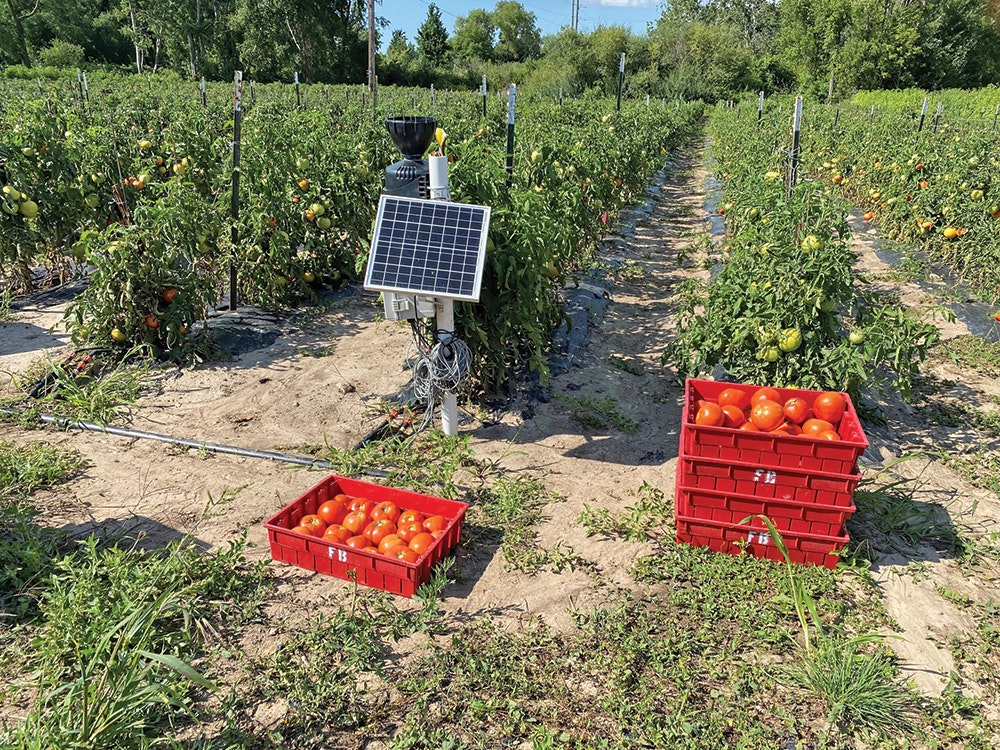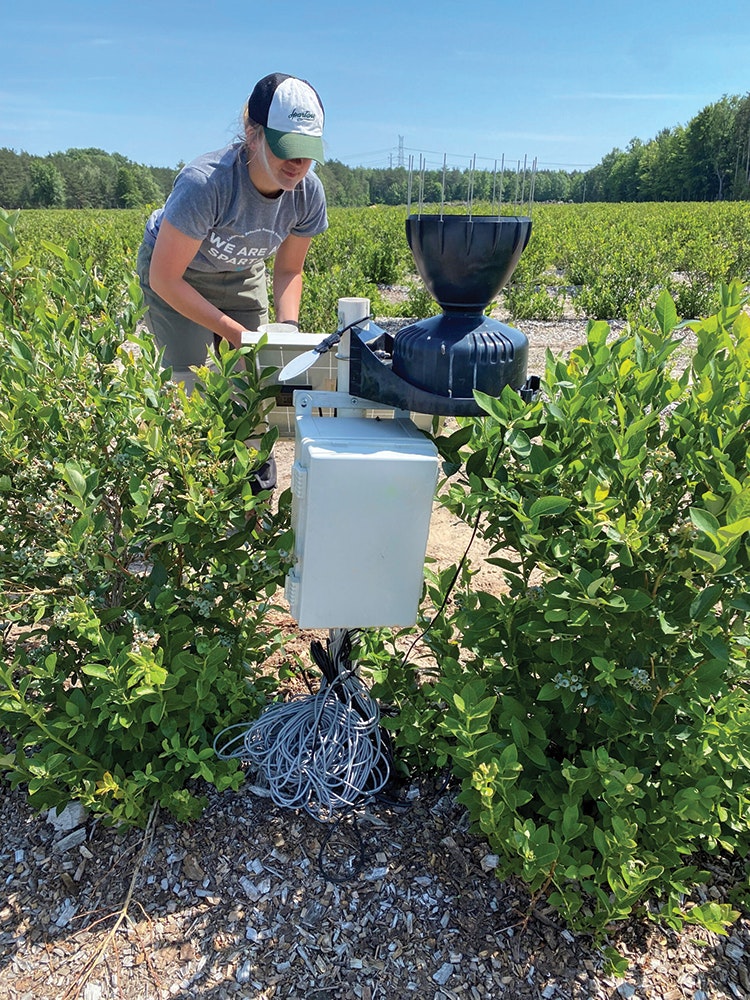Sensory Help: Equipment Tech Saves Water in Fields

March 31, 2025
By: Staff
Because managing irrigation can be difficult, Extension researchers are developing equipment that can improve water flow management to more efficiently irrigate fruit and vegetables.
By helping growers reduce pest and disease spraying, the sensors being field tested could save growers costs and time, and could change the way growers approach and manage irrigation and pest and disease challenges, said Extension specialist Younsuk Dong, an assistant professor and irrigation specialist in Michigan State University’s (MSU) Department of Biosystems and Agricultural Engineering. Dong is also a part of the Fruit + Vegetable Class of 2024 40 Under 40 honorees.
Unpredictable weather can bring extremes. In states such as Michigan, some of the driest and wettest months on record have occurred in the last several years. In drier times, when diseases may be less prevalent, farmers often look to irrigation to supplement lagging rainfall.
Fine tuning the systems, however, can be tricky, with too much water producing
unintended disease consequences.
To help growers wade through the challenges, MSU researchers have developed and are field testing a low-cost irrigation monitoring system called LOCOMOS (Low-Cost Monitoring System), which uses affordable sensors and monitoring tools to provide real-time data on soil moisture levels.

Equipment tech saves water in fields, orchards Irrigation monitoring technology being developed and tested at Michigan State allows growers to determine optimal irrigation schedules and amounts, helping conserve water while maximizing yields. Photos courtesy of Michigan State University.
The technology allows growers to determine optimal irrigation schedules and amounts, helping conserve water while maximizing yields.
In the ongoing research, researchers are testing a solar-powered microinverter prototype they developed at MSU research farms and five grower cooperators in west-central Michigan as well as Indiana.
The studies are examining blueberries, asparagus, carrots, tomatoes and potatoes, as well as field corn and soybeans, in a variety of cropping systems.
Leaf, Soil Moisture Tests
LOCOMOS’ in-field sensors measure soil moisture, leaf wetness and other environmental conditions. The data is analyzed by software that generates precise irrigation recommendations and delivers the advice to growers via an easy-to-use smartphone app. Despite water being free in Michigan, it still costs growers to pump it. Overwatering increases leaching and nitrate movement.
“It’s a great opportunity to use our water more responsibly and efficiently,” Dong said. “Less water pumping provides energy savings to the farmers. For the folks who are growing tomatoes or any fruit and veggies in sandy soil, it helps to reduce the risk of leaching nitrates and nutrients. Because you’re putting in more water, it means you’re probably going to over-irrigate, which has the potential of leaching a tree.”
With data from more expensive commercial-grade monitoring systems difficult to interpret, easier to use and understand simpler app systems using low-cost sensors are needed, and would be more accessible to most growers, Dong said.
Additionally, the systems could also help growers who may over irrigate, which can increase plant disease risk. The informed timings could help reduce spraying costs for fungicides and other sprays.
Solar Powered
Researchers plan to collaborate with utility companies connecting the solar-powered microinverters and review energy use efficiencies gained through irrigation scheduling, including estimated cost savings from less overall and peak-time power usage.
The data would help influence improving the prototype. Grower feedback will be continuously received, aiding a decision support tool that factors field conditions, crop type, irrigation pump size and other information.

In the tomato tests, sensor-based scheduling saved 30% on water use versus the grower’s typical irrigation method. Calculations aren’t complete for the other crops, Dong said. In the corn and soybean fields, LOCOMOS improved yields and irrigation water use efficiencies while not increasing disease incidence.
Dong works with Ben Werling, a Hart, Michigan, MSU Extension vegetable educator who aids commercial vegetable producers in west central and northwest Lower Michigan. The collaboration added leaf wetness and temperature components to the system.
Dong envisions the tool as being holistic, dealing with the entirety of plant health. Data, saved on a local drive including an SD card, can be sent to the cloud every 15 minutes.
Informed timings show potential in areas. While examining water spraying, Dong said the system would measure and integrate other inputs, including fertilizer and soil management practices, fungicides and other sprayings.
“How long the plant leaves are wet each day and what was the temperature when the leaves were wet — this data can allow us to predict disease risk,” he said.
Because growers could reduce timely field visits for moisture checking, the system could also reduce the need for crop consultant visits, data collection and analysis and report purchasing, Dong said.
Dong wants to move the system from simply delivering data to automatically making adjustments for growers. That has been accomplished in Dong’s tomato drip irrigation system tests. When a sensor shows less moisture, it can automatically trigger the irrigation systems.
“As we experience more unpredictable precipitation patterns, it makes it more difficult to determine when to turn irrigation on and off,” he said. “I really hope this tool could help growers make more informed decisions and that we can increase climate resiliency by using some of this climate smart technology, maybe through adaptation, mitigation and environmental sustainability.”
Improving irrigation could especially be helpful in tomatoes, where growers growing on sandy soil may receive four inches of rain but find dry soil the next day.
“If you have sandy ground, it doesn’t matter whether you get one inch or five or six inches,” Dong said. “That’s where I believe the sensor technology can help to better understand the moisture level and if a grower must turn irrigation on that day and how much.”
Dong leads the work funded by USDA Natural Resources Conservation Service (NRCS) and the Michigan Department of Agriculture & Rural Development (MDARD) which includes support from the MSU Innovation Center.
Other projects have utilized LOCOMOS, including Project GREEEN (Generating Research and Extension to meet Economic and Environmental Needs), which supports industry-driven research to improve plant agriculture, the Michigan Potato Industry Commission and Michigan soybean, field corn and bean growers.
